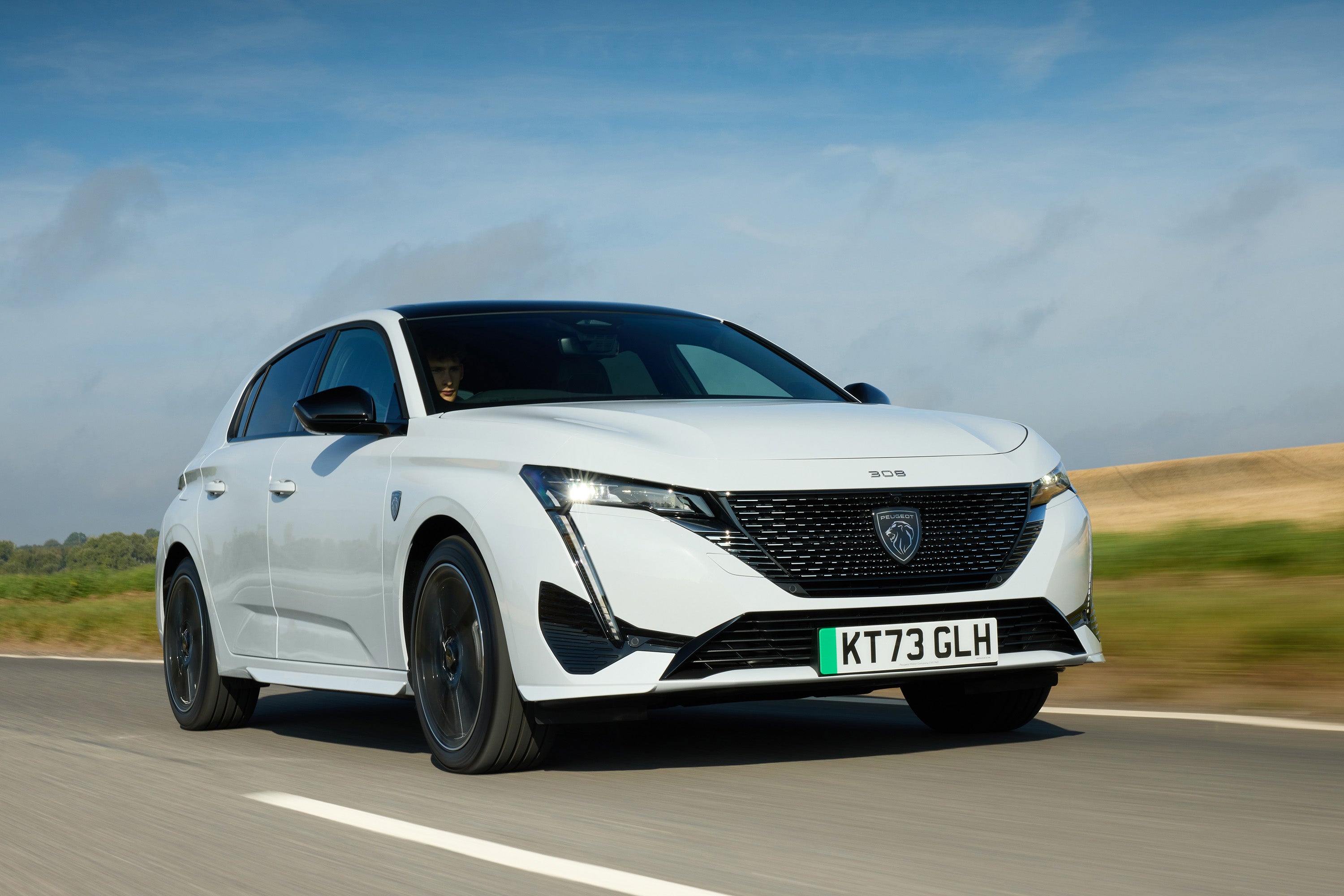Peugeot e-308 Review 2025: Price, specs & boot space
Written by Ivan Aistrop
- 2023
- Hatchback
- EV
Quick overview
Pros
- Pleasant to drive
- Nice interior finish
- Good refinement
Cons
- So-so practicality
- Real-world range could be better
- Driving position might irritate some
Overall verdict on the Peugeot e-308
“The latest generation of the Peugeot 308 arrived in 2021, packing a variety of petrol and plug-in hybrid powertrains. However, it wasn’t until 2023 that the all-electric e-308 version arrived, bringing zero-emissions appeal to the French firm’s popular family hatchback.”
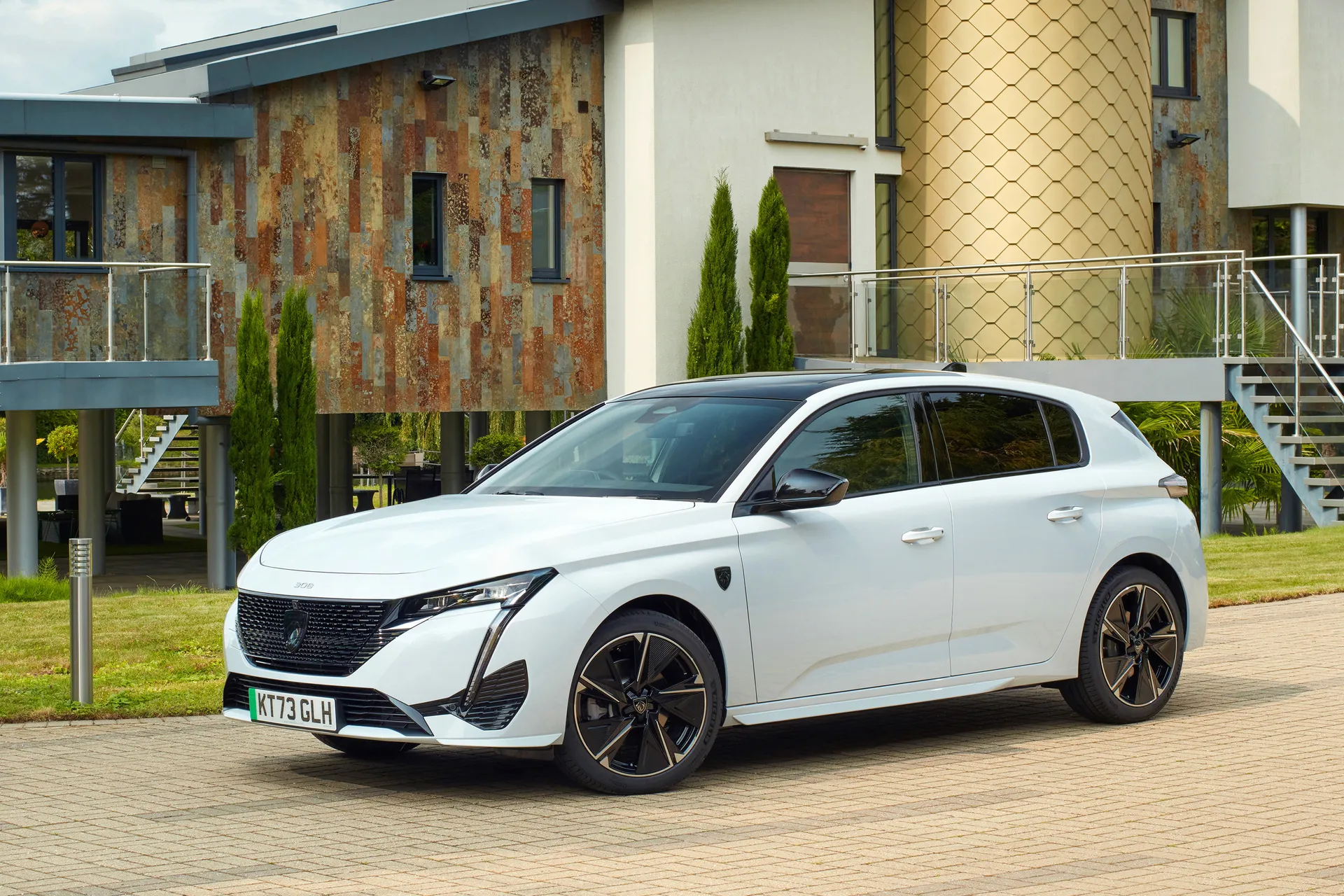
On paper, the accompanying figures look pretty compelling. The 54kWh battery gives a range of up to 257 miles on a single charge according to official WLTP figures, while a maximum power output of 156PS promises sparkling performance. We’d advise curtailing your expectations on both fronts, however, because as we’ll discover, the reality is actually a bit different.
Otherwise, the major appeal of the e-308 is exactly the same as that of the regular 308. It looks great on the outside, feels stylish and plush on the inside, it feels polished to drive, and it comes with a good slice of standard equipment for the money. It’s not stupidly expensive by electric car standards, although it’s certainly not cheap, either, but we’d advise looking at the used car market as there are incredible savings to be made on as-good-as-new examples.
A family estate version - known as the 308 SW - is available for a little added practicality, but we’ve reviewed that separately, so we’re concentrating on the regular hatchback version here. The hatchback is acceptable rather than exceptional in the practicality stakes, but it should suit a small family reasonably well.
Other than its stylish looks, we can’t think of a single thing that the Peugeot e-308 does brilliantly compared with its family hatchback rivals - electric or otherwise - but it does a thoroughly convincing job in every area. That makes it a very capable - not to mention likeable - all-rounder.
Is the Peugeot e-308 right for you?
The Peugeot e-308 will suit an electric family car buyer who wants to go about their daily motoring with a touch of style and a touch of luxury. It looks really cool inside and out, it has a high-class interior, and you also get lots of standard equipment for your money. Look at the used car market, and there are some fabulous deals to be had, too.
What's the best Peugeot e-308 model/battery to choose?
The Peugeot e-308 comes with just one powertrain, so there’s pretty much no choice to be made on that score. When it comes to choosing between Allure and GT trim levels, we’d stick with Allure. It comes with plenty of luxury kit, and GT trim doesn’t get much more, yet is quite a bit more expensive.
What other cars are similar to the Peugeot e-308?
The car that’s most like the Peugeot E-308 is the Vauxhall Astra Electric. That’s because the two cars share the same platform, batteries, motors and pretty much everything else, courtesy of them both being built by huge manufacturing conglomerate, Stellantis.
In terms of other all-electric family hatchback rivals, the Volkswagen ID.3 will spring to most minds, as will the Cupra Born. Extend your search into SUV-esque crossover models, meanwhile, and you’ll choose from far more models including the Renault Megane E-Tech, Honda e:Ny1, Ford Explorer, Citroen e-C4, and many more.
Comfort and design: Peugeot e-308 interior
"When looking at the Peugeot e-308, you might hear your Peugeot salesperson banging on about something called i-Cockpit. This is a contrived marketing name for the individual way that the French firm approaches interior design, and centres around the arrangement of your driving position."
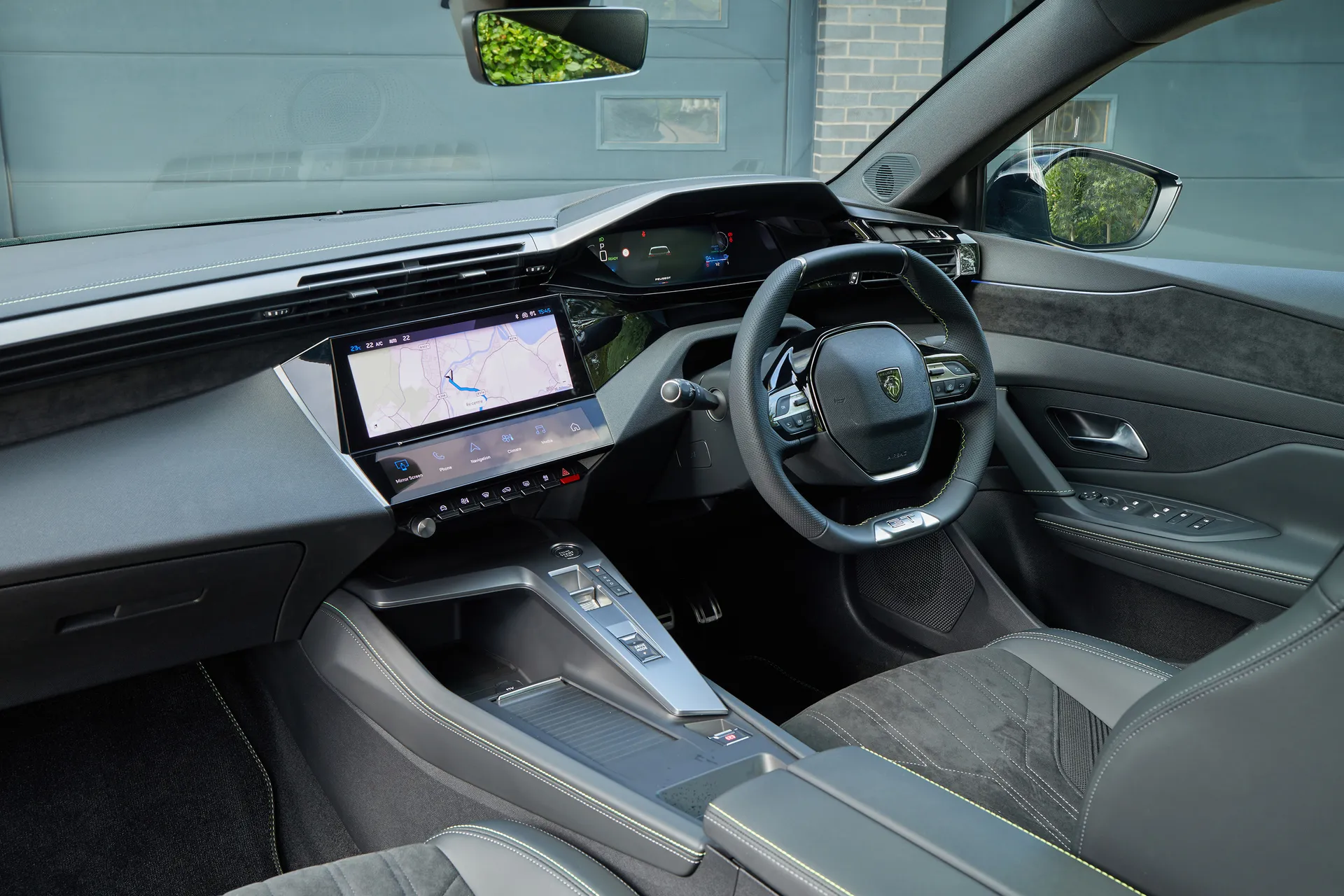
In the vast majority of cars, you look at your driving instruments through your steering wheel. In the e-308, though, as in many Peugeots, you instead have a teeny-tiny steering wheel, and you view the digital instrument panel over the top of it. Peugeot reasons that this places your driving information closer to your view of the road, so your eyes don’t have to move as far to see it.
Now, that may well be true, but it also has the side effect of placing your steering wheel further down towards your knees. While some people won’t be bothered by this, others will find that it feels really awkward, and will probably never get on with it however long they have to acclimatise. If you’re particularly long-of-leg, you might struggle to squeeze your knees under the wheel at all when it’s set in a position that allows you to see the instrument screen.
Manual seat and steering wheel adjusters are standard on both trims, while electric seats with a massage function can be added as an option to GT cars.
Quality and finish
The E-308’s interior is just as stylish and plush-feeling as we’ve come to expect from modern Peugeots. The big glossy-looking screens immediately lend things a sophisticated feel, and the variety of shapes, colours and textures on show make for an environment that feels modern and cool. Many of the materials have a high-end finish as well, although look outside of your direct eye line, and you will spot a few surfaces that aren’t of such a high standard. The way everything is assembled feels very solid, too.
Infotainment: Touchscreen, USB, nav and stereo in the Peugeot e-308
All versions of the Peugeot e-308 get a 10.0-inch digital instrument screen behind the steering wheel, along with a 10.0-inch central touchscreen that supports Bluetooth, DAB, Apple CarPlay, Android Auto, and voice recognition. You also get six speakers and USB ports front and rear.
Upgrade from Allure trim to GT trim, and you also get connected 3D TomTom navigation, plus i-Toggle, which constitutes a second narrow touchscreen strip below the regular one that brings customisable shortcuts.
Either way, the system isn’t too difficult to navigate, with reasonably logical menus and a fairly intuitive interface. We’d prefer physical air-con controls rather than these being integrated into the touchscreen, but these are becoming less and less common these days. What might annoy you most about the system, though, is that some of the animations that occur between screen transitions take an annoyingly long time, and the screen sensitivity isn’t great, so your instruction isn’t always registered at the first attempt.
It’s also a little surprising that wireless smartphone charging is an optional extra across the range, rather than being standard on the top trim.
Space and practicality: Peugeot e-308 boot space
The e-308 does an adequate job in this area, but no more than that. There’s enough headroom and legroom for a pair of six-foot adults to sit in the Peugeot e-308’s rear seats fairly comfortably. They won’t have room to stretch out, though, and several rival hatchbacks provide more generous room, both above passengers, and in front of them. Small rear door openings mean you feel slightly impeded when getting in and out, too.
The footwells feel quite cramped as well, so you won’t be able to move your feet around too much once you’re in, and things feel extra cramped on that score when a third person sits in the middle seat because they have to sit with their feet either side of a hump in the centre of the floor, robbing those either side of a bit more foot space. Not that you’ll want to travel like this too often, mind, because the middle seat is narrower than the outer ones, and the cabin is a bit too narrow for everyone to sit comfortably.
The Peugeot e-308’s boot space stands at 361 litres, which is the same as in the PHEV version of the 308, but down on the combustion-engined version’s 412 litres, and it sits a little below the class average. There are 60/40 split-folding rear seats to open up more cargo-carrying capacity, but when they drop, they lie at a slight angle and don’t sit quite flush with the boot floor, so the extended load bay you get is both stepped and sloped.
Handling and ride quality: What is the Peugeot e-308 like to drive?
"The Peugeot e-308 delivers a very convincing balance of abilities on the road, so you get a good blend of comfort and agility."
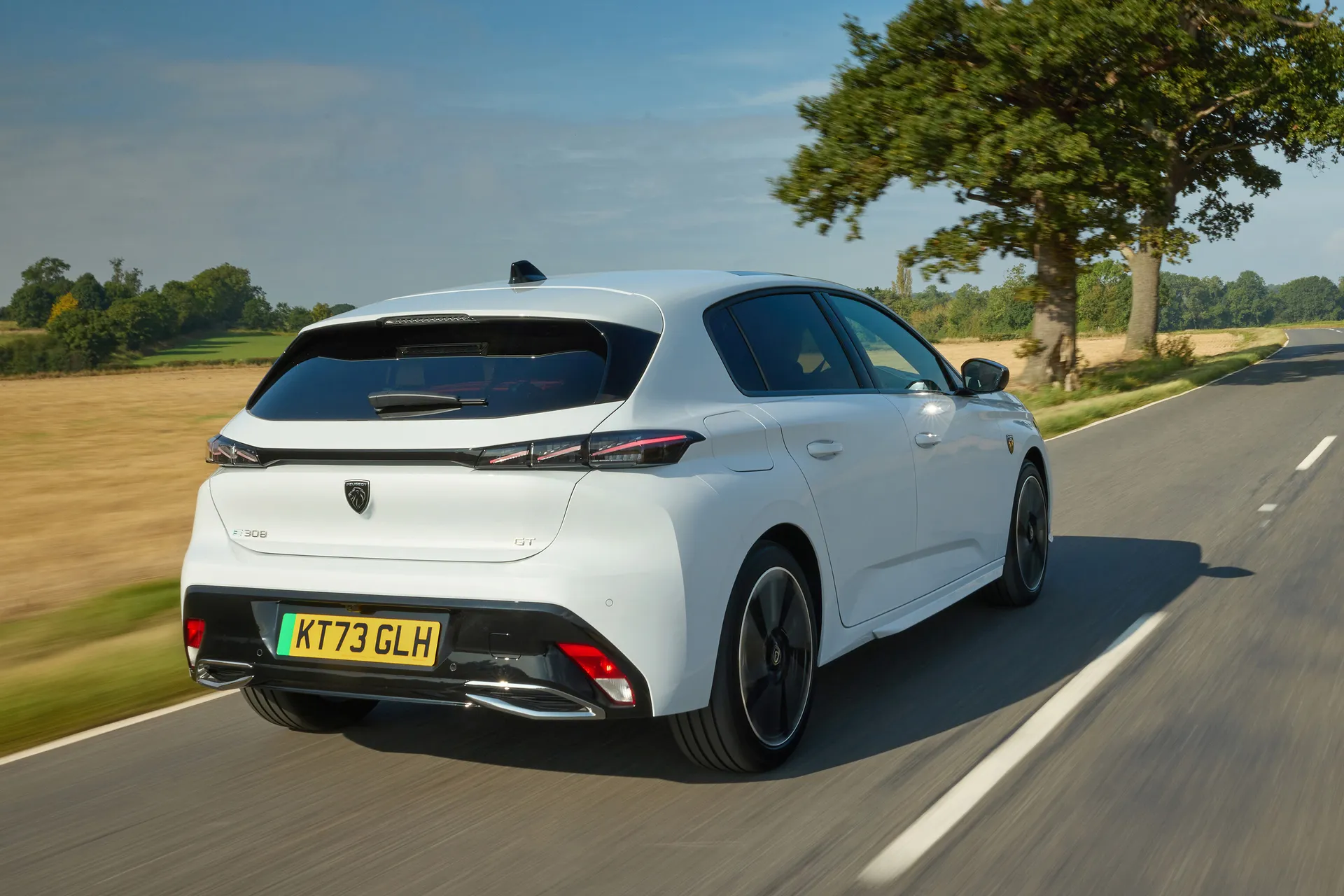
OK, so it isn’t class-leading on either score: a Volkswagen Golf rides more smoothly and a Seat Leon changes direction more crisply. However, the suspension is more forgiving than it is in many rivals for an impressive level of ride comfort, and despite some discernible body roll to be felt in corners, it feels more nimble than some other rivals.
Happily, the Peugeot e-308 doesn’t feel as heavy as many electric cars do (it’s actually quite light by EV standards at 1.7 tonnes), either when you’re changing direction or hard on the brakes. The small steering wheel dupes you into thinking that the steering is quicker and more responsive than it actually is, so there’s an alert feel to it, even if you don’t get much in the way of feedback.
Overall, then, the Peugeot e-308 isn’t exactly game-changing in any way regarding how it drives, but you’ll have no reason for complaint, either.
What motors and batteries are available in the Peugeot e-308?
The Peugeot e-308’s front-mounted electric motor is powered by a 54kWh lithium-ion battery. It’s capable of delivering a maximum of 156PS of power and 270Nm of torque, and under optimum conditions, it’ll see off the 0-62mph dash in 9.8 seconds.
For all that to happen, though, you need to select Power mode with the drive mode switch on the centre console. When you start the car, it defaults to Normal mode, which gives you a little less in the way of power and torque: 136PS and 250Nm, respectively. This gives you a few extra miles of range. For a few more still, you can dial things back even further by selecting Eco mode, which gives you 109PS and 220Nm and limits the operation of the heating and climate control.
As the 0-62mph time would suggest, the car never feels desperately fast even in its punchiest mode. Pickup is eager off the mark, but once you’re moving, your pace is unfurled gradually rather than all at once. In actual fact, you’ll notice very little difference in sensation between Power and Normal modes.
There’s a more marked difference with Eco mode, where performance feels that bit more strangled, but it’s fine for most driving situations and it never feels unnervingly underpowered, so you don’t feel like you're holding other road users up.
What never goes away, regardless of the mode you select, is the Peugeot e-308’s rather sloppy throttle response. Push the Go pedal, and there’s always a frustrating gap of around half a second or so before the car responds to your request.
The Peugeot e-308 has two levels of regenerative braking. In its normal setting, there’s hardly any, so you can coast along like you would in a conventionally powered car. If you select B-mode by pushing the button on the drive selector, it becomes much more pronounced, although not strong enough to constitute the whole one-pedal driving experience that so many electric car manufacturers bang on about. It’s all pretty easy to modulate, though.
Peugeot E-308 range: How far can you travel on a charge?
According to official WLTP figures, the Peugeot e-308 will do ‘up to 257 miles’ on a single charge. You’ll do very well to match that in the real world, though, especially in cold weather or if you’re spending lots of time on the motorway. We did around 90 miles on a chilly January day, around half of which were motorway miles, and our battery level dropped from 85% to 27%, which suggests a real-world range of about 155 miles under these circumstances.
Refinement and noise levels
The Peugeot e-308 does a good job in this area. In some Stellantis-built EVs, the motor can make a bizarre-sounding whine as you manoeuvre at low speeds, but we detected none of that in the e-308, and it remains almost silent at all speeds. Wind- and road noise are also well suppressed at motorway speeds, so this is generally a quiet and relaxing car to bimble around in.
Safety equipment: How safe is the Peugeot e-308?
The Peugeot e-308 is different to most other versions of the 308 in that all versions get adaptive cruise control with stop-and-go function as standard. You also get other preventative driving aids including autonomous emergency braking, lane keeping assist, speed limit recognition, driver attention warning, and high beam assist headlights.
GT replaces these lights with full matrix adaptive LED headlights, along with LED rear lights that do a little dance for you when you unlock the car. You also get emergency call assistance.
The 308 was crash-tested by Euro NCAP in 2022, when it achieved four out of five stars.
Peugeot e-308 charging times: How much does it cost to charge?
"We wouldn’t recommend relying on a normal three-pin domestic plug to charge your Peugeot e-308 on a regular basis. There are three reasons for this. It’s not great for your home’s electrical system, you have to pay extra for the cable that allows you to do it, and it takes 14 hours and 40 minutes to charge your battery from 20% to 80%."
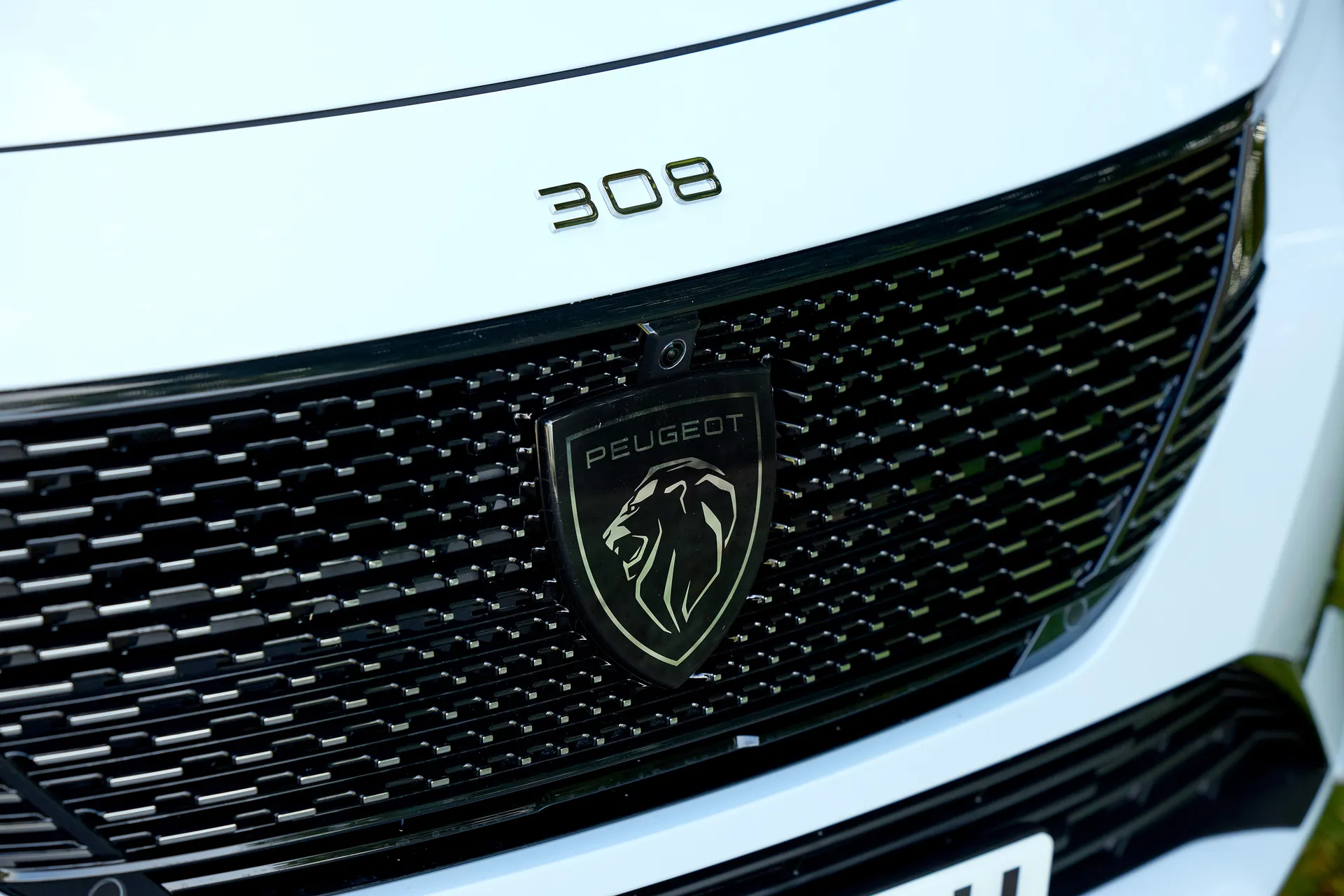
In fact, all of Peugeot’s quoted charging time figures are for a 20% to 80% top-up. Do as most buyers will, and use a 7.4kW wall box home charger, and that charge will take four hours and 25 mins, and cost around £9 (assuming that your domestic power is charged at the UK’s national average). A full charge will cost around £14, meanwhile.
Take your Peugeot e-308 to an appropriately powerful DC public rapid charger, and it’ll charge at a rate of up to 100kW, delivering that same 20% to 80% charge in 30 minutes. However, it’ll be a lot more expensive - we’re talking three times as much, usually - than charging up on domestic power.
Peugeot e-308 reliability and warranty
Have a look at our go-to source of reliability data, the HonestJohn.co.uk Satisfaction Index, which is put together by our excellent sister website, and it makes for fairly grim reading. Peugeot was voted as the second least reliable manufacturer in the whole study, and the last-generation 3008 SUV - which is closely mechanically related to the contemporary 308 hatchback - was voted as the second least reliable model in the entire study.
Peugeot’s warranty is no great shakes, either, with the bog-standard three-year, 60,000-mile cover being the least any new car buyer should expect these days. The Peugeot e-308’s battery, meanwhile, is protected by eight-year, 100,000-mile cover, which will result in complementary replacement or repair of the battery if it falls below 70% of its original capacity within the warranty period.
Hopefully yo,u can take solace from the fact that, in theory at least, electric cars are likely to be more reliable than their combustion-engined counterparts because they have far fewer moving parts. That’s also why the Peugeot e-308’s service intervals are relatively broad at every two years or 16,000 miles.
Peugeot e-308 insurance groups and costs
Nice and simple, this. Go for an Allure-spec car, and it’ll sit in insurance group 24. Go for a GT, or get yourself a First Edition from the used car market, and it’ll sit in group 25. There are 50 insurance groups, with group 1 cars being the cheapest to insure, and group 50 cars being the most expensive. That should prepare you for fair-to-middling premiums on the Peugeot e-308.
VED car tax: What is the annual road tax on a Peugeot e-308?
For a long time, drivers haven't had to pay a penny in Vehicle Excise Duty (VED) on electric cars. The rules are changing from April 2025, though, when the Exchequer will scrap VED exemption for EVs, meaning that electric cars will be liable for the same road tax costs as regular combustion-engined cars. That’s charged at £190 per year at the time of writing, but we’d be very surprised if that didn’t go up in as well. Good luck, everyone.
Peugeot E-308 price
"If bought brand new, the Peugeot e-308 hatchback costs around £38,000 in Allure trim, or just over £40,000 when specified in GT trim."
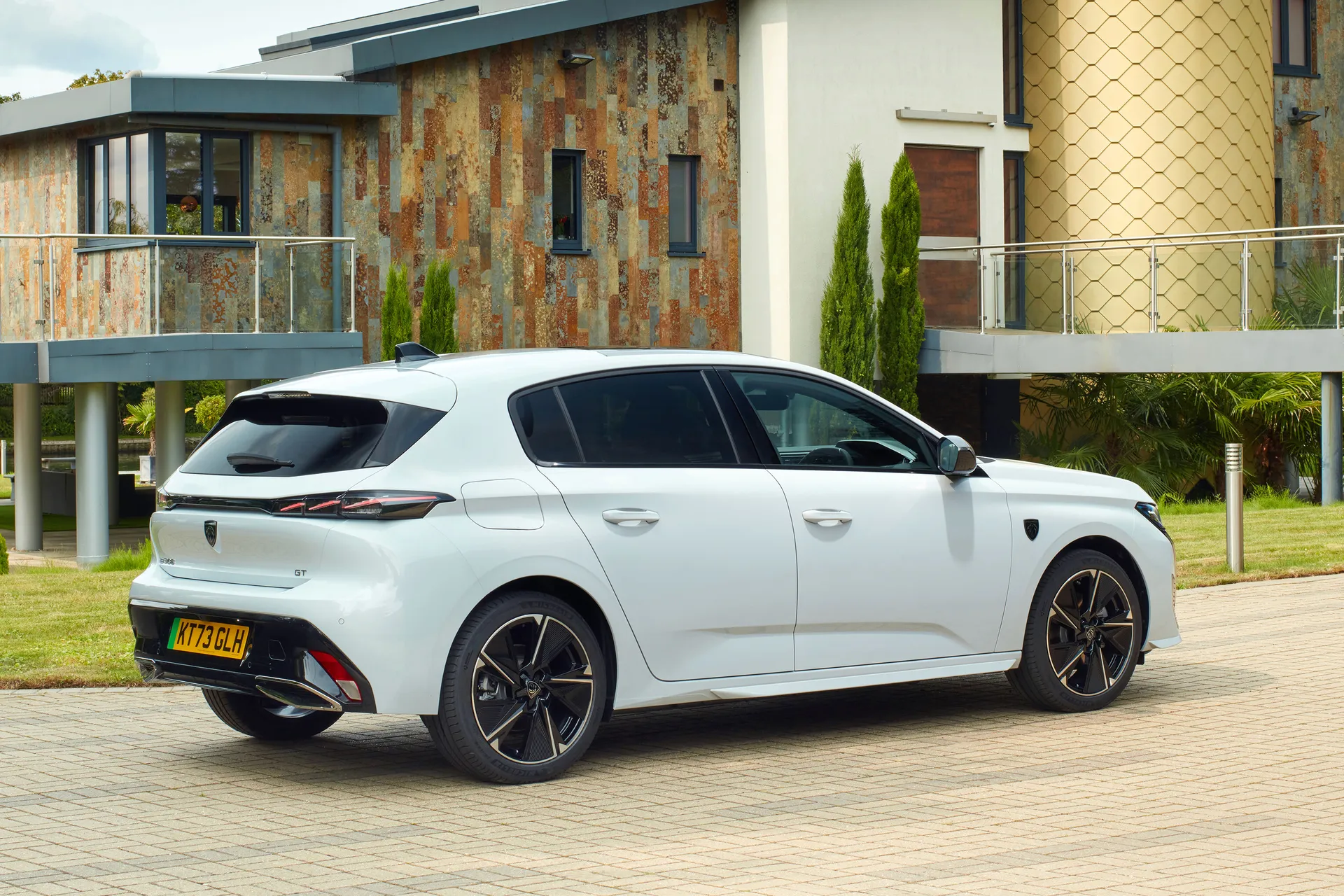
However, despite the fact that the model hasn’t been around all that long, there are still some jaw-droppingly large savings to be made by turning the used car market. Browse the heycar listings, and you’ll see examples of less than a year old with super-low four-figure mileages on them for around £25,000, and most of these are higher-spec GT cars. There’s lots of choice for this sort of money, too.
Trim levels and standard equipment
The E-308 comes in two trim levels. The lower-grade one is called Allure, but even that comes with plenty. The standard roster includes 18-inch alloy wheels, a chromed grille, rear privacy glass, electric front- and rear windows, cruise control, automatic air-conditioning, an electric parking brake, a heated steering wheel, a 180-degree reversing camera, part-leather upholstery, manual seat adjustment, and heated front seats.
GT trim adds sportier body styling, chequered chrome grille finish, aluminium door sills, keyless entry, a leather steering wheel, ambient lighting, carpet mats, and front parking sensors. Initially, there was also a high-spec First Edition trim, but this has since been discontinued.
Ask the heycar experts: common questions
Is the Peugeot e-308 an electric car?
Is the Peugeot e-308 an electric family car?
How far can the Peugeot e-308 go on a single charge?
Get our latest advice, news and offers
Keep me updated by email with the latest advice, news and offers from heycar.
By submitting you agree to our privacy policy
